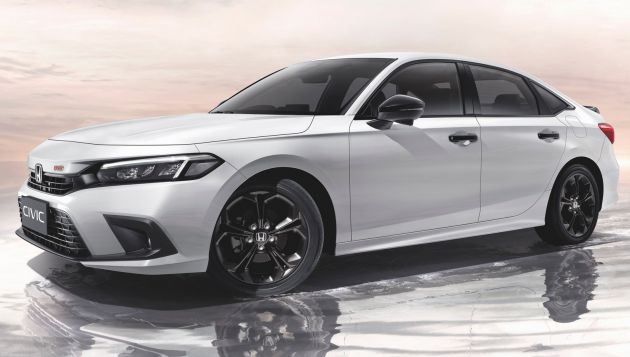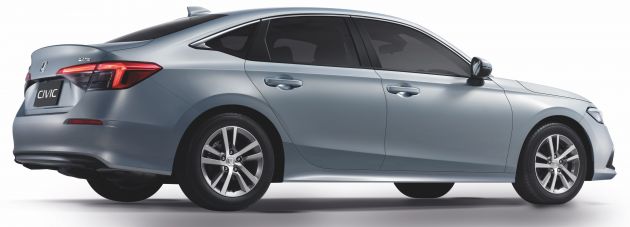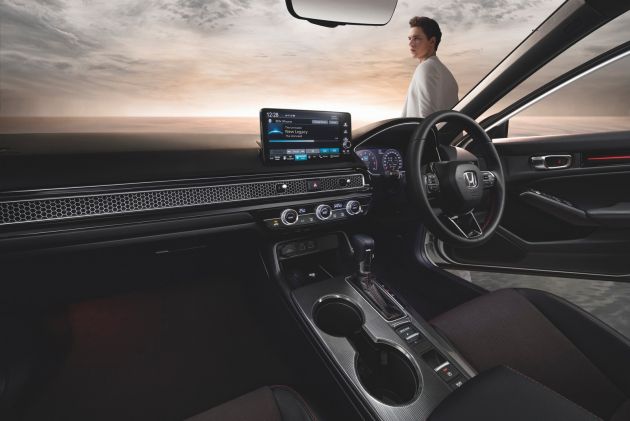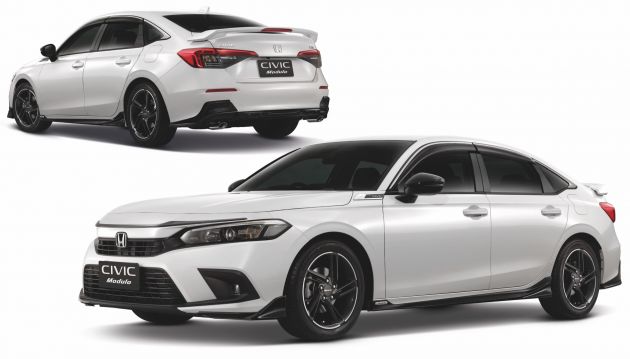Four months after the global reveal of the new Honda Civic, the 11th-generation C-segment sedan has been launched in Thailand today. As we’ve previously reported, there’s an all-new design, some new convenience and safety technologies and an uprated engine, but there are also some eyebrow-raising spec changes for the Land of Smiles, as you’re about to read.
First up, let’s talk about pricing, which starts at 964,900 baht (RM122,100) for the base EL, rising up to 1,009,900 baht (RM127,800) for the EL+. The RS model tops the range and retails at quite a steep premium, costing 1,199,900 baht (RM151,800).
With the new model, Honda has ditched the long-serving 1.8 litre naturally-aspirated i-VTEC four-cylinder base engine. All variants are now powered by the same 1.5 litre VTEC Turbo mill, tuned to deliver quicker throttle response and greater high-end performance.
The power output is slightly lower than it is in other markets – at 178 PS (made at 6,000 rpm), the Thai-market car produces 4 PS less than those in the United States and Japan. Still, that’s a useful 5 PS jump over the outgoing model, while torque has gone up 20 Nm from 1,700 to 4,500 rpm. Honda is quoting a combined fuel consumption figure of 17.2 kilometres per litre.
We’ve gone over the styling of the new Civic many times already (and I’m sure you’ve already made up your mind about it). Just to recap, however, the sedan features a more mature and restrained look, with slimmer headlights, the removal of the “Solid Wing Face” chrome front bar, a longer bonnet and a simple straight shoulder line running from the front lamps to the trapezoidal taillights.
The RS model adds the usual sporty tweaks, including black door mirrors and door handles and an additional black bootlid spoiler. Unfortunately, the Thai-market Civic doesn’t get the handsome 18-inch alloy wheels available in other markets, maxing out at 17 inches (with a matte black finish) on the RS. The other models roll on 16-inch two-tone items.
Against the measuring tape, the Civic is 4,678 mm long, 1,802 mm wide and 1,415 mm tall, making it 30 mm longer, three millimetres wider and one millimetre lower; its 2,733 mm wheelbase is also 33 mm longer. Honda says that the latter provides more legroom, especially for rear occupants.
Inside, the Civic is decidedly more premium than the outgoing model in appearance, sporting a simple horizontal dashboard, a freestanding infotainment touchscreen and full-width air vents with a honeycomb metal mesh cover. The company promises improved material and switchgear quality in concert with the more upmarket look, as well as increased visibility thanks to the A-pillars being pushed 50 mm rearward.
The car also features a swathe of new technologies, including the HondaConnect infotainment system from the latest Accord. This is exclusive to the RS, featuring a nine-inch touchscreen, wireless Apple CarPlay and remote vehicle functionality via a smartphone app. The EL and EL+ are fitted with a seven-inch display and wired CarPlay. No Bose sound system here, unfortunately, but you do get eight speakers on the EL+ and RS.
As standard, the Civic comes with automatic halogen projector headlights, LED daytime running lights, LED taillights, keyless entry, walk-away auto lock, push-button start, fabric seats, single-zone auto climate control, a seven-inch instrument display and a reverse camera. The EL+ adds auto-folding door mirrors, a leather-wrapped steering wheel, leather upholstery and an eight-way power-adjustable driver’s seat
Stepping up to the RS throws in full-LED headlights, auto wipers, black Ultrasuede upholstery, red ambient lighting, an auto-dimming rear-view mirror, dual-zone climate control, alloy pedals, paddle shifters and a new Sport driving mode. Other new features that are exclusive to the RS are a four-way powered front passenger seat, a Qi wireless smartphone charger and a slimline Honda Smart Key Card.
Most importantly, all variants of the new Civic now come as standard with the Honda Sensing suite of driver assistance systems, including autonomous emergency braking, adaptive cruise control, lane centring assist, lane keeping assist, automatic high beam and front departure alert, the last one being a new addition.
Unlike in other markets, however, the Thai Civic is not equipped with Traffic Jam Assist (TJA), which provides Level 2 semi-autonomous driving capabilities at speeds of under 65 km/h. Honda has also chosen to retain the LaneWatch camera instead of a conventional blind spot monitor; this is only fitted to the RS.
Six airbags continue to come as standard, without the dual knee airbags found elsewhere. A new rear seat reminder joins the usual stability control, hill start assist and rear ISOFIX child seat anchors. Rear seat belt reminders are exclusive to the RS.
Honda is also offering a range of Modulo accessories at launch, giving budding boy racers a chance to customise their cars from the showroom. The basic aero package consists of a black front splitter, side skirts and rear diffuser, all in all costing 18,500 baht (RM2,300).
Miss the aforementioned Solid Wing Face? You can add a chrome grille garnish as part of the 8,900 baht (RM1,100) Sport Package, which also adds fake rear vents. Adding a rear wing turns the package into the Exclusive Sport Package that retails at 17,200 baht (RM2,200), while chrome exhaust finishers cost an extra 1,950 baht (RM250).
Other bits include black 17-inch turbine-style alloys at 5,250 baht (RM660), illuminated side sill scuff plates at 5,100 baht (RM640), black door mirror covers at 1,950 baht (RM250) and footwell illumination at 2,200 baht (RM270).
@paultancars 2022 ##Honda ##Civic launched in ##Thailand. Will ##Malaysia be next? ##paultancars ##paultan ##carsoftiktok ##fyp? ##foryou ##foryourpage



























